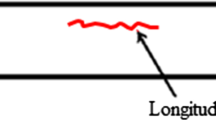Abstract
The dynamics and diagnostics of a cracked rotor have been gaining importance in recent years. The early detection of faults like fatigue cracks in rotor shafts are very important to prevent catastrophic failure of the rotor system. Vibration monitoring during start up or shut-down is as important as during steady state operation to detect cracks especially for machines such as aircraft engines which start and stop quite frequently and run at high speeds. So, the transient data of the cracked rotor has been transformed using the wavelet transforms for crack detection. Most of the works quoted in the literature used 1D wavelets or 2D wavelets (Continuous Wavelet Transform-CWT) for crack detection. The crack detectors in the signals are both time as well as frequency dependent. So, the use of 2D wavelets is also not enough to detect the crack. In the present work a 3D wavelet (CWT) has been utilized which clearly indicates both the time and frequency features of the crack. The presence of sub-criticals in the CWT may be a best crack indicator but it is not always reliable. The addition of noise to the signal may sometimes lead to inaccurate results. So, there is a need to identify a parameter in addition to the sub-criticals. The phase angle between the two signals (cracked and un-cracked) or two transverse vibrations can be a better crack indicator because it is very less sensitive to noise disturbance. So, to extract the above phase angle a new transform has been applied called Cross Wavelet Transform (XWT). The XWT is exploited for the first time to a rotor fault detection system in the present work. Some interesting results have been obtained using the same. The advantage of the XWT is that both, the phase angles between the transverse signals and also the amplitudes of sub-criticals are viewed in a single plot. Parametric analysis is also carried out by varying crack depth and crack position for diagnostic purposes. The inverse problem of crack identification (i.e. determining the crack parameters through known vibration data) has also been carried out using Artificial Neural Network (ANN).
Similar content being viewed by others
References
Christopher Torrence, Gilbert P Compo 1998Apractical guide to wavelet analysis. Bull. Am. Meteorol. Soc. 79(1): 61–78
Dimarogonas A D 1996 Vibration of cracked structures: A state of the art review. Eng. Fracture Mech. 55: 831–857
Grinsted A, Moore J C, Jevrejeva S 2004 Application of the cross wavelet transform and wavelet coherence to geophysical time series
Matlab tool box, Version 7.0
Prabhakar S, Sekhar A S, Mohanty A R 2001 Detection and monitoring of cracks in a rotor-bearing system using wavelet transforms. Mechanical Systems and Signal Processing 15(2): 447–450
Sabnavis G, Kirk R G, Kasarda M, Quinn D 2004 Cracked shaft detection and diagnostics: A literature review. The Shock and Vibration Digest 4: 287–296
Sekhar A S, Prabhu B S 1994 Transient analysis of a cracked rotor passing through the critical speed J. Sound and Vibration 173: 415–421
Sekhar A S 2003 Crack detection through wavelet transform for a run up rotor. J. Sound and Vibration 259(2): 461–472
Wauer J 1990 Dynamics of cracked rotors: a literature survey. Appl. Mech. Rev. 43(1): 13–17
Zang C, Imregun M 2001 Structural damage detection using artificial neural networks and measured FRF data reduced via principal component projection. J. Sound and vibration 242(5): 813–827
Author information
Authors and Affiliations
Corresponding author
Rights and permissions
About this article
Cite this article
Nagaraju, C., Narayana Rao, K. & Mallikarijuna Rao, K. Application of 3D wavelet transforms for crack detection in rotor systems. Sadhana 34, 407–419 (2009). https://doi.org/10.1007/s12046-009-0024-y
Received:
Revised:
Published:
Issue Date:
DOI: https://doi.org/10.1007/s12046-009-0024-y




